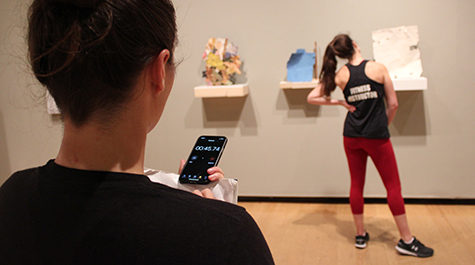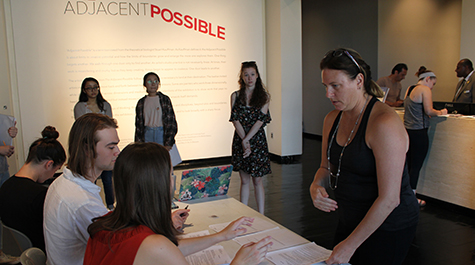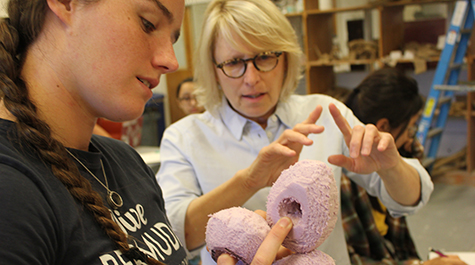Fine art and hard science converge in new course
This fall, the Muscarelle Museum of Art will serve as both an exhibit space and laboratory for a new interdisciplinary course that blends art and science.
“Neuro-aesthetics: The artist and the mind” is new COLL course team-taught by Elizabeth Mead, professor in William & Mary’s Department of Art and Art History, and Jennifer Stevens, associate professor in the university’s Department of Psychological Sciences. The duo conceived of the idea while serving as W. Taylor Reveley III Interdisciplinary Fellows.
“There are lots of initiatives these days to pair art and science,” Mead said. “The majority of them are about the art illustrating the science or the science explaining the art, but my argument is that they are equal. One should not be in the service of the other, but rather each should be true to itself.”
{{youtube:medium:center|S8YMOKJNLlY}}
The course centers around examining the aesthetic experience of abstract art and how it varies from representational art, Mead explains. She curated an exhibition to coincide with the course, which will be on display through Sept. 27. The exhibit title, “The Adjacent Possible,” comes from a term coined by the theoretical biologist Stuart Kauffman.
“The adjacent possible is real,” he writes. “It is part of the persistent creativity of the universe, biosphere, economy and history. Ceaseless creativity has become physically possible.”
The theme of the exhibit ponders an area of science called neuro-aesthetics, a field that investigates perception, production and response to art. The exhibit has the dual role of considering the creative process of the artists and analyzing viewers’ perspectives when confronted with abstract art.
“It’s important to understand that abstraction isn’t just about a Mark Rothko painting, it is also the underlying force in representational work as well,” Mead said. “At the end of the day, it is about looking. This course is about teaching people how to see.”
This exhibition features contemporary works from a group of living artists: Michelle Benoit, Phil Chang, Stefan Chinov, Jaynie Crimmins, Sara Dochow, Diane Englander, Pamela Farrell, Karen Fitzgerald, Helen O’Leary, Lorraine Tady, Jo Volley and Susan York. The twelve invited artists make works that span across mediums and dimensions, Mead said. She added that their works have informed her teaching.
“If students are in the actual presence of the work, rather than just seeing images, they will have an entirely different experience,” Mead said. “They are able to stand in front of it and have a conversation with the person next to them. It will give them greater access to the art.”
Students enrolled in the course spend one day a week with Mead, creating and learning about abstract art, and another day with Stevens, learning about human perception and cognition. The students will use the Muscarelle as a literal laboratory throughout the course, studying the art inside the museum and running studies about how visitors perceive the art.
“One of the things that I find fascinating is the difference between creative processes versus observational processes and how these two communicate,” Stevens said. “So naturally, there is a strong research component to the course.”
Stevens says students will be responsible for designing studies that touch on her research specialty, the neuroscience of representation and perception. She explains this will work particularly well with Mead’s area of expertise: abstraction.
“We know that words and narrative play a large role in memory,” Stevens said. “Memories by and large start around the time that you begin to talk. That is because you can encode them with language. When it comes to something like abstract art, you don't always have the vocabulary. You’re not really told what you are looking at, so it’s akin to pre-linguistic encoding, something that you feel, but don't have words to describe.”
In one example of a potential study, Stevens says students could change the titles for the art in the Adjacent Possible exhibit and gauge how audience response varies.
“What if you are given a title that matches and is insightful?” Stevens said. “And then what happens when you are given a title that doesn’t match the art? It could be the same artwork, but for one viewer it has the title ‘Evening Sunset’ and for another viewer it’s called ‘Yellow’ or ‘Five.’”
The results may demonstrate how language affects image processing, she said, adding that the university’s access to the museum is what makes the research possible.
“I’ve always thought of the Muscarelle like you would think of a teaching hospital within a medical school,” Stevens said. “I love that students are using it as an investigative tool, a learning tool, rather than art for art’s sake. As far as I know, this is the first time that there’s been an exhibit at the Muscarelle that’s used in this kind of pedagogical manner, which is momentous and inspiring.”
Exhibit runs through Sept. 27. Hours are 10 a.m. to 5 p.m. Tuesday-Friday. More info is available at the Muscarelle’s website.


















